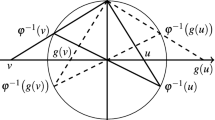Abstract
This paper is mainly concerned with the study of circle-preserving property of Möbius transformations acting on \(\widehat{\mathbf{R}}^{n}=\mathbf{R} ^{n}\cup \left\{\infty \right\}\). The circle-preserving property is the most known invariant characteristic property of Möbius transformations. Obviously, a Möbius transformation acting on \(\widehat{\mathbf{R}}^{n}\) is circle-preserving. Recently, for the converse statement, some interesting and nice results have been obtained. Here, we investigate these studies. We consider the relationships between Möbius transformations and sphere-preserving maps in \(\widehat{\mathbf{R}} ^{n}\) since the studies about the circle-preserving property of maps in \(\widehat{\mathbf{R}}^{n}\) are related to the study of sphere-preserving maps. For the case n = 2, we also consider the problem whether or not the circle-preserving property is an invariant characteristic property of Möbius transformations for the circles corresponding to any norm function \(\left\Vert.\right\Vert\) on \(\mathbf{C}\).
Access this chapter
Tax calculation will be finalised at checkout
Purchases are for personal use only
Similar content being viewed by others
References
Aczel, J., Mckiernan, M.A.: On the characterization of plane projective and complex Moebius-transformations. Math. Nachr. 33, 315–337 (1967)
Beardon, A.F.: Curvature, circles, and conformal maps. Am. Math. Mon. 94(1), 48–53 (1987)
Beardon, A.F..: The Geometry of Discrete Groups. Graduate Texts in Mathematics, 91. Springer-Verlag, New York (1995)
Beardon, A.F., Minda, D.: Sphere-preserving maps in inversive geometry. Proc. Am. Math. Soc. 130(4), 987–998 (2002)
Blair, D.: Inversion Theory and Conformal Mapping. Student Mathematical Library, issue 9. American Mathematical Society, Providence (2000)
Bulut, S., Özgür, N.Y.: A new characteristic of Möbius transformations by use of Apollonius points of pentagons. Turk. J. Math. 28(4), 299–305 (2004)
Bulut, S., Özgür, N.Y.: A new characterization of Möbius transformations by use of apollonius points of (\(2n-1\))-gons. Acta Math. Sinica Engl. Ser. 21(3), 667–672 (2005)
Caratheodory, C.: The most general transformations of plane regions which transform circles into circles. Bull. Am. Math. Soc. 43, 573–579 (1937)
Coxeter, H.S.M.: Introduction to geometry. Wiley, New York (1969)
Ford, L.R.: Automorphic functions. Chelsea, New York (1951)
Gibbons, J., Webb, C.: Circle-preserving transformations. Notices Am. Math. Soc. 22, 68–2 (1975). (Abstract)
Gibbons, J., Webb, C.: Circle-preserving functions of spheres. Trans. Am. Math. Soc. 248(1), 67–83 (1979)
Haruki, H.: A proof of the principle of circle-transformations by use of a theorem on univalent functions. L’enseignement Math. 18, 145–146 (1972)
Haruki, H., Rassias, T.M.: A new invariant characteristic property of Möbius transformations from the standpoint of conformal mapping. J. Math. Anal. Appl. 181(2), 320–327 (1994)
Haruki, H., Rassias, T.M.: A new characteristic of Möbius transformations by use of Apollonius points of triangles. J. Math. Anal. Appl. 197(1), 14–22 (1996)
Haruki, H., Rassias, T.M.: A new characteristic of Möbius transformations by use of Apollonius quadrilaterals. Proc. Am. Math. Soc. 126, 2857–2861 (1998)
Haruki, H., Rassias, T.M.: A new characterization of Möbius transformations by use of Apollonius hexagons. Proc. Am. Math. Soc. 128(7), 2105–2109 (2000)
Höfer, R.: A characterization of Möbius transformations. Proc. Am. Math. Soc. 128(4), 1197–1201 (1999)
Jeffers, J.: Lost theorems of geometry. Am. Math. Mon. 107, 800–812 (2000)
Jones, G.A., Singerman, D.: Complex Functions. An Algebraic and Geometric Viewpoint. Cambridge University Press, Cambridge (1987)
Lehner, J.: Discontinuous Groups and Automorphic Functions. Mathematical Surveys. 8. American Mathematical Society, Providence (1964)
Li, B., Wang, Y.: Transformations and non-degenerate maps. Sci. China Ser. A. 48, 195–205 (2005)
Li, B., Yao, G.: On characterizations of sphere-preserving maps. Math. Proc. Camb. Philos. Soc. 147(2), 439–446 (2009)
Li, L., Yao, G.: A new characterization for isometries by triangles. N. Y. J. Math. 15, 423–429 (2009)
Nehari, Z.: Conformal Mapping. McGraw-Hill, New York (1952)
Niamsup, P.: A note on the characteristics of Möbius transformations. J. Math. Anal. Appl. 248(1), 203–215 (2000)
Samaris, N.: A new characterization of Möbius transformation by use of 2n points. J. Nat. Geom. 22(1–2), 35–38 (2002)
Yao, G.: On existence of degenerate circle-preserving maps. J. Math. Anal. Appl. 334(2), 950–953 (2007)
Yao, G.: Transformations of spheres without the injectivity assumption. Quasiconformal mappings, Riemann surfaces, and Teichmüller spaces. Contemp. Math. Am. Math. Soc. Providence 575, 371–375 (2012)
Yı lmaz Özgür, N.: On some mapping properties of Möbius transformations. Aust. J. Math. Anal. Appl. 6(13), 8 (2010)
Yı lmaz Özgür, N., Bulut, S.: A note on the characteristic properties of Möbius transformations. Rad. Mat. 12, 129–133 (2004)
Yı lmaz Özgür, N., Bulut, S.: On the invariant characteristic properties of Möbius transformations. Nonlinear Funct. Anal. Appl. 10(5), 885–894 (2005)
Yı lmaz Özgür, N., Bulut, S., Özgür, C.: On the images of the helix under the Möbius transformations. Nonlinear Funct. Anal. Appl. 10(5), 743–749 (2005)
Acknowledgments
The author would like to thank Prof. Th. M. Rassias for his encouragement to prepare this survey.
Author information
Authors and Affiliations
Corresponding author
Editor information
Editors and Affiliations
Rights and permissions
Copyright information
© 2014 Springer Science+Business Media, LLC
About this chapter
Cite this chapter
Özgür, N. (2014). On the Circle Preserving Property of Möbius Transformations. In: Rassias, T., Pardalos, P. (eds) Mathematics Without Boundaries. Springer, New York, NY. https://doi.org/10.1007/978-1-4939-1106-6_17
Download citation
DOI: https://doi.org/10.1007/978-1-4939-1106-6_17
Published:
Publisher Name: Springer, New York, NY
Print ISBN: 978-1-4939-1105-9
Online ISBN: 978-1-4939-1106-6
eBook Packages: Mathematics and StatisticsMathematics and Statistics (R0)



